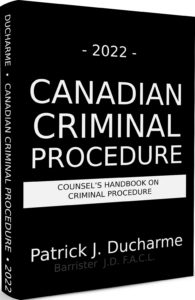 |
| Patrick J Ducharme |
Part XVI of the Code deals with compelling the appearance of an accused and interim judicial release. It also applies to the detention and release of young persons, except to the extent that the provisions may be inconsistent with the Youth Criminal Justice Act [the “YCJA”].
The YCJA provides additional principles governing the detention of young persons. For example, the YCJA codifies the earlier case law that held that a young person must not be detained in custody as a substitute for appropriate child protection, mental health or other social measures.
Further, in determining whether the detention of a young person is necessary for the protection or safety of the public under subsection 515(10)(b) of the Code, substantial likelihood the young person will commit an offence or interfere with the administration of Justice, there is a presumption that detention is unnecessary under this paragraph if the young person could not, upon being found guilty, be committed to custody.
A young person who is arrested and detained prior to sentencing must be detained in a facility designated as a place of “temporary detention” and therefore must not be held in a facility for young persons serving custodial sentences.3 A young person in detention must be held separately from adults. The only exception to this is in circumstances where the court is satisfied, having regard to the best interests of a young person, he or she cannot be detained in a place of detention for young persons, having regard to his or her own safety or the safety of others, or, where there is no place of detention within a reasonable distance.
Pursuant to subsection 30(4), the Provincial Director may apply to the court to transfer a young person who is eighteen years old to an adult Provincial prison, and, after affording the young person an opportunity to be heard, the court may authorize the move to an adult facility, if it is in the best interests of the young person or in the public interest. Where a young person is twenty years old or older at the commencement of pre-trial detention, the young person must be detained in a Provincial prison for adults.
Section 31 provides that a young person who would otherwise be detained in custody under section 515 of the Code may be placed in the care of a responsible person, on conditions, where the court is satisfied that there is a responsible person willing and able to take care of or exercise control over the young person, and, the young person is willing to be placed in the care of that person. The court conducting the hearing must inquire as to the availability of a responsible person if the young person would otherwise be detained in custody.4 Any time that the placement with a responsible adult is terminated, the young person is brought back before the court to determine whether a substitute placement may be arranged or to proceed to conduct a full bail hearing.
A young person charged with the offence of murder, or any other offence listed in section 469 of the Code, may only be released by a Superior Court Justice. The review of that decision is heard by the Court of Appeal in accordance with section 680 of the Code.
The review proceedings are generally the same as those applicable to adults. However, where a Justice of the peace conducts the original bail hearing, the young person may apply to a youth court Judge. The matter is heard as an original application.

The above is the an excerpt of Patrick J Ducharme's book, Canadian Criminal Procedure, available at Amazon or in bulk through MedicaLegal Publishing along with Criminal Trial Strategies.
Subscribe to Patrick Ducharme's Youtube Channel
